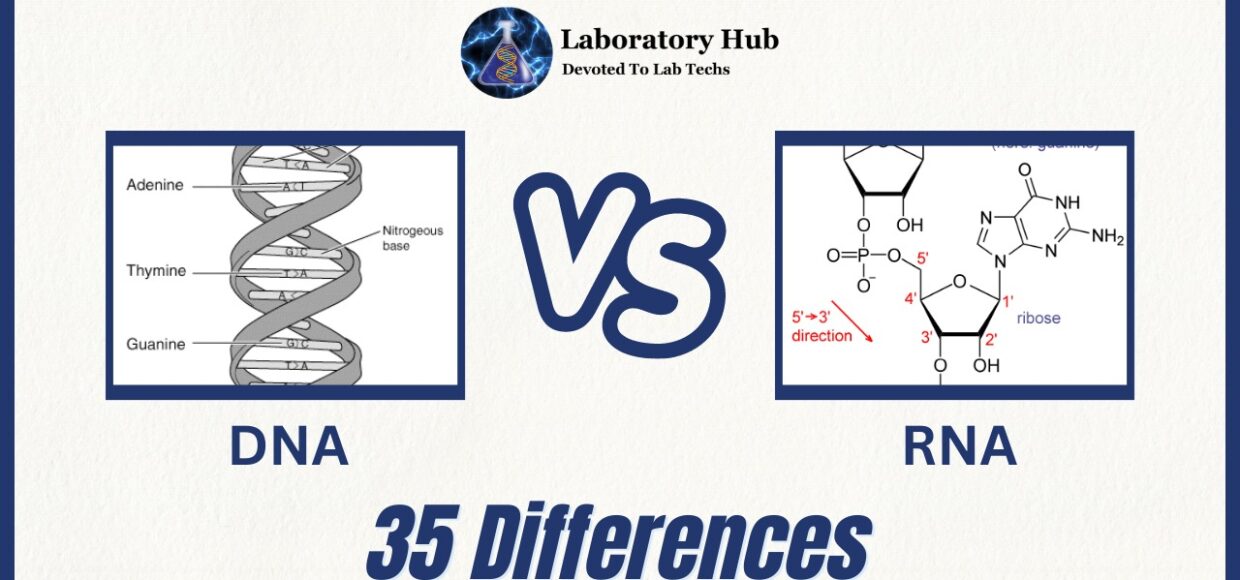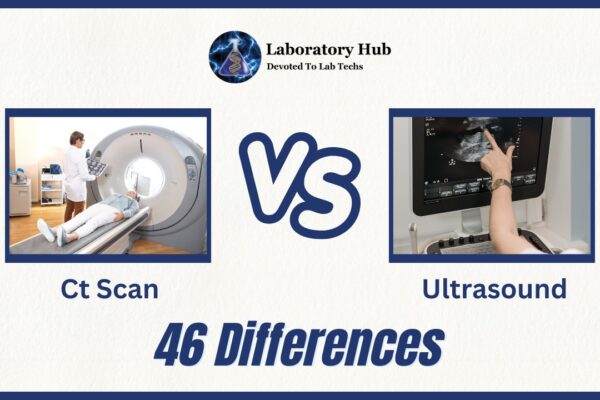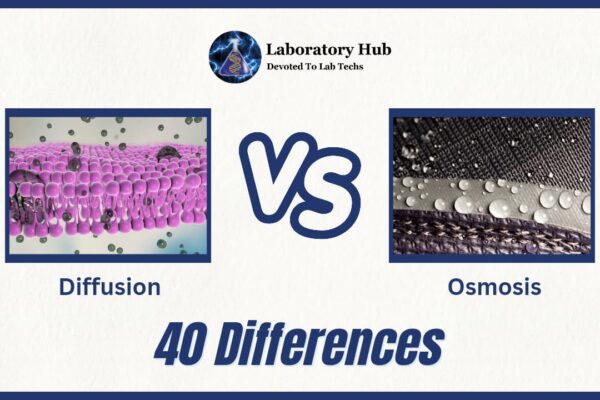DNA vs RNA- 35 Key Differences
In molecular biology, DNA and RNA are the building components of life’s genetic code. In all living things, DNA and RNA store, transmit and express genetic information. Understanding DNA and RNA’s similarities and differences is essential to understanding life.
Nucleotides form DNA, the blueprint of life. Nucleotides have phosphate, deoxyribose, and one of four nitrogenous bases: adenine (A), guanine (G), cytosine (C), or thymine (T). An organism’s features, functions, and hereditary information are determined by the DNA base sequence.
However, RNA, a single-stranded molecule, is needed for protein synthesis and gene expression. Nucleotides with a phosphate group and ribose make up RNA. However, RNA’s nitrogenous base composition replaces thymine (T) with uracil (U). Adenine, guanine, cytosine, and uracil are RNA’s four bases.
Despite having identical chemical compositions, DNA and RNA have different roles and structures. DNA stores genetic information long-term in the cell nucleus. Through transcription, it creates RNA. DNA’s genetic instructions are translated by RNA to the cellular machinery that synthesizes proteins. Protein assembly also requires transfer RNA (tRNA) and ribosomal RNA (rRNA).
In this detailed look at DNA vs. RNA, we’ll examine their unique traits, roles, and complex interactions. We’ll explain DNA replication, transcription, and translation, which underpin all living things. By understanding the similarities and differences between DNA and RNA, we begin a fascinating adventure to interpret life’s complicated genetic code.
S.No. | Category | DNA (Deoxyribonucleic Acid) | RNA (Ribonucleic Acid) |
1 | Definition | Genetic material that carries hereditary information in most organisms. | A molecule involved in various biological processes, including gene expression and protein synthesis. |
2 | Full Name | Deoxyribonucleic Acid | Ribonucleic Acid |
3 | Sugar Component | Contains deoxyribose sugar in its backbone. | Contains ribose sugar in its backbone. |
4 | Nucleotide Composition | Composed of nucleotides: adenine (A), cytosine (C), guanine (G), and thymine (T). | Composed of nucleotides: adenine (A), cytosine (C), guanine (G), and uracil (U). |
5 | Double-Stranded vs Single-Stranded | Generally double-stranded, forming a double helix structure. | Usually single-stranded, but can form secondary structures through base pairing. |
6 | Helical Structure | Has a right-handed helical structure. | Can have different types of secondary structures, such as hairpins and loops. |
7 | Stability | More stable and less susceptible to degradation. | Relatively less stable and more prone to degradation. |
8 | Location | Found primarily in the cell nucleus (nuclear DNA). | Found in the nucleus, cytoplasm, and other cellular compartments. |
9 | Function | Stores and transmits genetic information for protein synthesis and inheritance. | Plays various roles, including protein synthesis, gene regulation, and enzymatic activities. |
10 | Gene Expression | DNA serves as a template for RNA synthesis during transcription. | RNA is involved in gene expression and carries the genetic instructions for protein synthesis. |
11 | Types | Two main types: nuclear DNA and mitochondrial DNA. | Several types, including messenger RNA (mRNA), transfer RNA (tRNA), and ribosomal RNA (rRNA). |
12 | Coding vs Non-Coding | Most DNA is non-coding, with only a small portion coding for proteins. | RNA includes both coding (mRNA) and non-coding (rRNA, tRNA, etc.) molecules. |
13 | Replication | DNA replication occurs during the cell division process. | RNA is generally not replicated but synthesized as needed. |
14 | Base Pairing | Adenine (A) pairs with thymine (T), and cytosine (C) pairs with guanine (G) via hydrogen bonds. | Adenine (A) pairs with uracil (U), and cytosine (C) pairs with guanine (G) via hydrogen bonds. |
15 | Role in Protein Synthesis | DNA provides the template for mRNA synthesis, which is then used to synthesize proteins. | mRNA carries the genetic information from DNA to the ribosomes for protein synthesis. |
16 | Enzymes Involved | Enzymes involved in DNA processes include DNA polymerase and DNA ligase. | Enzymes involved in RNA processes include RNA polymerase and various RNA-modifying enzymes. |
17 | Genome Size | Typically has a larger genome size. | Generally has a smaller genome size compared to DNA. |
18 | Epigenetic Modifications | DNA can undergo epigenetic modifications, such as methylation, affecting gene expression. | RNA can also undergo modifications, such as methylation and pseudouridylation. |
19 | Introns and Exons | DNA contains introns (non-coding regions) and exons (coding regions) in eukaryotes. | RNA can contain introns (pre-mRNA) that are later spliced out to form mature mRNA. |
20 | Role in Evolution | DNA carries genetic information that contributes to the evolutionary process. | RNA, particularly RNA viruses, can have a high mutation rate, influencing evolutionary changes. |
21 | Telomeres | DNA has telomeres at the ends of chromosomes, protecting them from degradation. | RNA does not have telomeres. |
22 | Polymerase Chain Reaction (PCR) | PCR amplifies specific DNA sequences. | Reverse transcription PCR (RT-PCR) is used to amplify RNA sequences. |
23 | Enzyme Reverse Transcriptase | DNA does not require reverse transcriptase enzyme for its synthesis. | RNA uses reverse transcriptase enzyme for the synthesis of DNA (cDNA) in some cases. |
24 | Degradation | DNA is relatively more resistant to enzymatic degradation. | RNA is more susceptible to enzymatic degradation by RNases. |
25 | Transfer of Genetic Information | DNA carries genetic information from one generation to the next. | RNA transfers genetic information from DNA to protein synthesis machinery. |
26 | Role in Genetic Disorders | Mutations in DNA can lead to various genetic disorders. | Mutations in RNA can contribute to certain genetic disorders, particularly those involving RNA processing. |
27 | Enzyme Telomerase | DNA can be extended by the enzyme telomerase to replenish telomeres. | RNA can serve as a template for telomerase to extend telomeres. |
28 | Inheritance | DNA carries hereditary information from parents to offspring. | RNA is not directly involved in inheritance but plays a role in gene expression during development. |
29 | Half-Life | DNA has a longer half-life compared to RNA. | RNA has a shorter half-life, leading to rapid turnover in the cell. |
30 | Role in Genetic Engineering | DNA is commonly used in genetic engineering techniques, such as cloning and recombinant DNA technology. | RNA can be utilized in genetic engineering, particularly in RNA interference (RNAi) techniques. |
31 | Genetic Stability | DNA is more genetically stable due to repair mechanisms and less vulnerability to mutation. | RNA can be more prone to mutations and genetic instability. |
32 | Involvement in Diseases | DNA mutations are associated with various genetic diseases and cancer. | RNA dysregulation can contribute to diseases, including certain neurological disorders and viral infections. |
33 | Origin of Replication | DNA has multiple origins of replication along the chromosome. | RNA does not have a defined origin of replication. |
34 | Transport | DNA is not actively transported within the cell. | RNA molecules can be actively transported to specific cellular compartments. |
35 | Role in Evolutionary History | DNA carries the genetic information that underlies the history of species and evolutionary relationships. | RNA, particularly ribosomal RNA (rRNA), is used in phylogenetic analysis to study evolutionary relationships. |
Frequently Asked Questions (FAQs)
DNA and RNA are distinct. DNA has deoxyribose, and RNA ribose. Unlike RNA, DNA is double-stranded and forms a sturdy helix. DNA has thymine (T), while RNA has uracil (U).
Genetic information is stored in DNA. It encodes protein production and controls heredity. RNA delivers genetic information from DNA to protein production machinery. It regulates gene expression, transports amino acids, and assembles proteins.
During cell division, the DNA double helix splits, and two identical DNA strands are synthesized from each strand. This procedure accurately transfers genetic information to daughter cells. Transcription—RNA synthesis—occurs in the nucleus. RNA polymerase uses one DNA strand to make a corresponding RNA strand.
RNA has several kinds. mRNA transfers genetic information from DNA to ribosomes for protein synthesis. tRNA delivers amino acids to ribosomes during protein synthesis. Ribosomes, which synthesize protein, require rRNA. MiRNA and siRNA also regulate gene expression.
DNA mutations cause genetic illnesses. Understanding DNA sequence differences linked with certain illnesses enables for diagnostic testing and tailored therapy. RNA-based research, particularly mRNA vaccines, has changed medical research and helped generate COVID-19 vaccinations. RNA interference (RNAi) technology can also silence disease-causing genes to cure them.







